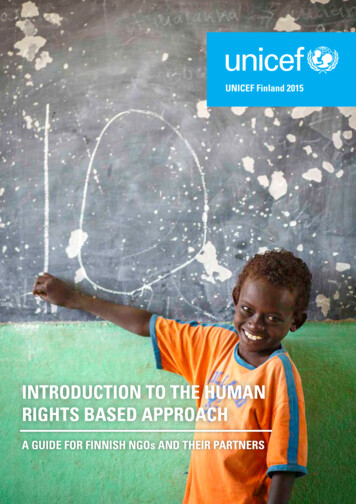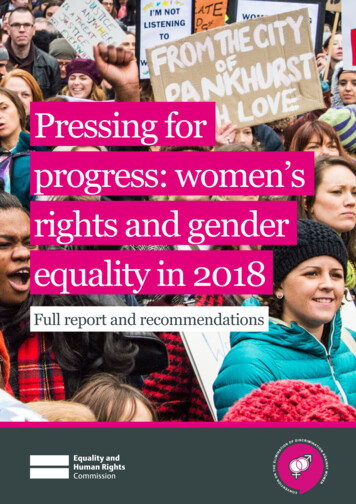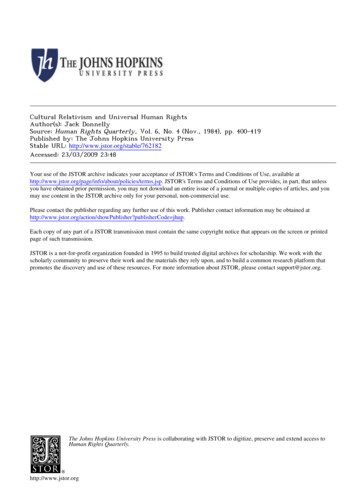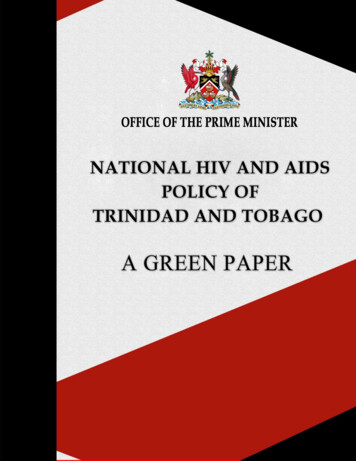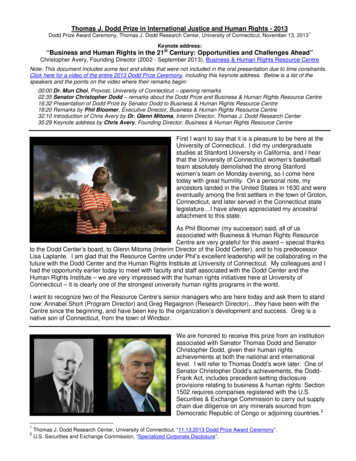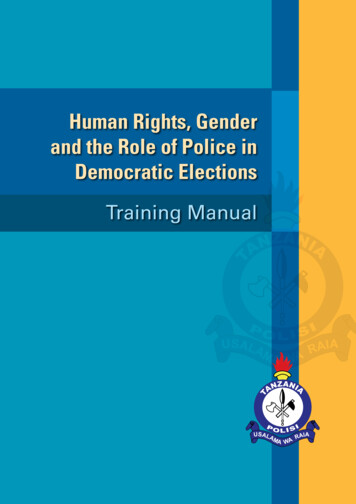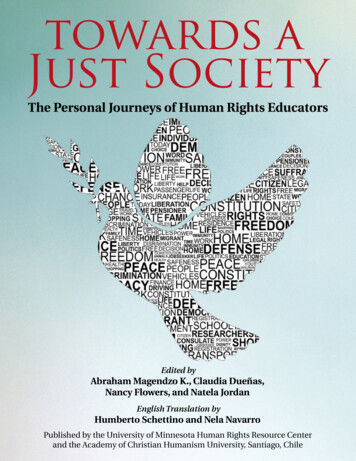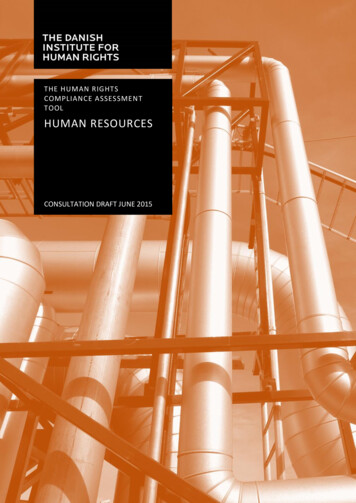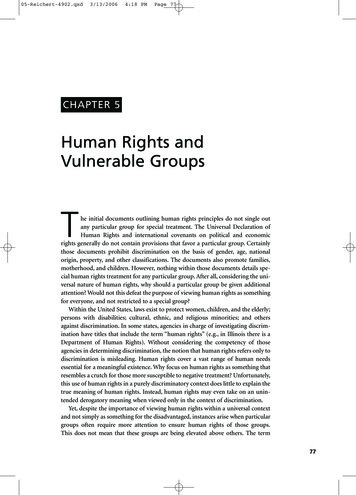
Transcription
05-Reichert-4902.qxd3/13/20064:18 PMPage 77CHAPTER 5Human Rights andVulnerable GroupsThe initial documents outlining human rights principles do not single outany particular group for special treatment. The Universal Declaration ofHuman Rights and international covenants on political and economicrights generally do not contain provisions that favor a particular group. Certainlythose documents prohibit discrimination on the basis of gender, age, nationalorigin, property, and other classifications. The documents also promote families,motherhood, and children. However, nothing within those documents details special human rights treatment for any particular group. After all, considering the universal nature of human rights, why should a particular group be given additionalattention? Would not this defeat the purpose of viewing human rights as somethingfor everyone, and not restricted to a special group?Within the United States, laws exist to protect women, children, and the elderly;persons with disabilities; cultural, ethnic, and religious minorities; and othersagainst discrimination. In some states, agencies in charge of investigating discrimination have titles that include the term “human rights” (e.g., in Illinois there is aDepartment of Human Rights). Without considering the competency of thoseagencies in determining discrimination, the notion that human rights refers only todiscrimination is misleading. Human rights cover a vast range of human needsessential for a meaningful existence. Why focus on human rights as something thatresembles a crutch for those more susceptible to negative treatment? Unfortunately,this use of human rights in a purely discriminatory context does little to explain thetrue meaning of human rights. Instead, human rights may even take on an unintended derogatory meaning when viewed only in the context of discrimination.Yet, despite the importance of viewing human rights within a universal contextand not simply as something for the disadvantaged, instances arise when particulargroups often require more attention to ensure human rights of those groups.This does not mean that these groups are being elevated above others. The term77
05-Reichert-4902.qxd3/13/20064:18 PMPage 7878——UNDERSTANDING HUMAN RIGHTSvulnerable refers to the harsh reality that these groups are more likely to encounterdiscrimination or other human rights violations than others.What Is a Vulnerable Group?In a human rights sense, certain population groups often encounter discriminatorytreatment or need special attention to avoid potential exploitation. These populations make up what can be referred to as vulnerable groups. For example, considerthe following:In the United States, only 6 percent of board seats within public companies areheld by minorities, with only 13.6 percent held by women (“Who Is Running theShow?” 2004);Child abuse by parents and others is a major problem throughout much of theworld, with special departments having been created to investigate complaints ofchild abuse (United Nations, 1989);Within the United States, African Americans continue to experience subtle, ifnot overt, discrimination in the form of inadequate educational facilities, lowerincomes than others, disproportionate number of males in prison, and so on;Elderly persons frequently find themselves victims of scams and other schemesthat cost them dearly financially and otherwise (United Nations, 1999);Ethnic cleansing or even genocide continues to occur in some parts of the world,with milder forms of discrimination on the basis of national or ethnic originoccurring elsewhere;Persons with disabilities often have no recourse to decent employment or adequate treatment; andHIV-AIDS afflicts large numbers of populations in many countries (UnitedNations, 2004).Circumstances in which a particular group encounters obstacles or impedimentsto the enjoyment of human rights could continue indefinitely. The idea that allthings are equal within the application or distribution of human rights remainsidealistic and outright naïve. For these reasons, human rights advocates haveemphasized the significance of vulnerable groups and the need to pay special attention to the human rights of those groups. When people are in unequal situations,treating them in the same manner invariably perpetuates, rather than eradicates,injustices (van Wormer, 2001).Women as a Vulnerable GroupIn societies around the world, female status generally is viewed as inferior and subordinate to male status (Bunch, 1991). Societies have modeled their gender-roleexpectations on these assumptions of the “natural order” of humankind. Historic
05-Reichert-4902.qxd3/13/20064:18 PMPage 79Human Rights and Vulnerable Groups——79social structures reflect a subordination of females to males. This subordinationoccurs withinthe organization and conduct of warfare,the hierarchical ordering of influential religious institutions,attribution of political power,authority of the judiciary, andinfluences that shape the content of the law (Bunch, 1991).The historic subordination, silencing, and imposed inferiority of women are notsimply features of society but a condition of society (Cook, 1995). Legal preceptstraditionally exclude women from centers of male-gendered power, including legislatures, military institutions, religious orders, universities, medicine, and law.Women’s Rights Are Human RightsSoon after the adoption of the Universal Declaration of Human Rights in 1948,criticism of its language arose. The declaration refers to “man” and uses the pronoun “he” when discussing individuals. While drafters of the declaration did notappear to intentionally exclude women from human rights, central concerns aboutthe male focus have persisted (Morsink, 1999). Subsequent human rights documents did little to correct the male orientation of human rights until 1980, whendelegates from the United Nations endorsed the Convention on the Elimination ofAll Forms of Discrimination Against Women (United Nations, 1980). Since then,the concept that human rights are for women, as well as men, has gained significantmomentum, if not always put into practice.Convention on the Elimination of AllForms of Discrimination Against WomenThe most prominent human rights document concerning the human rightsof women is the Convention on the Elimination of All Forms of DiscriminationAgainst Women (CEDAW). This convention became effective in September 1981,and at least 170 countries have approved the convention. The United States is oneof the few countries that has not ratified the convention.Provisions of CEDAWThe focus of CEDAW is elevating the status of women to that of men in the areaof human rights. Countries that agree to follow human rights principles containedin CEDAW recognize that the “full and complete development of a country, thewelfare of the world, and the cause of peace require the maximum participationof women on equal terms with men in all fields” (United Nations, 1981, preamble).Adherents to CEDAW note “the great contribution of women to the welfare of thefamily and to the development of society,” which so far is not fully recognized.
05-Reichert-4902.qxd3/13/20064:18 PMPage 8080——UNDERSTANDING HUMAN RIGHTSPromote positiveperceptions of andby womenEducate all womenregarding theirlegal rights andother lawspertinent to themPress for relevantgender-specificdata collectionand researchLook to thewomen: Listento the womenHuman RightsFree womenfrom fear anddominationInvest inhealth careand educationPlace womenin decisionmaking positionsFigure 5.1Require economicself-determinationValue allwomen’s workWomen and Human RightsSource: Adapted from Wood Wetzel, J. (1996). On the road to Beijing: The evolution of theinternational women's movement. Affilia: Journal of Women and Social Work, 11(22), 221–236.States “are aware that the role of women in procreation should not be a basis fordiscrimination but that the upbringing of children requires a sharing of responsibility between men and women and society as a whole.” Countries party to CEDAWagree to adopt measures required for elimination of gender discrimination in all its“forms and manifestations.”How does CEDAW define gender discrimination?Any distinction, exclusion, or restriction made on the basis of sex that has theeffect or purpose of impairing or nullifying the recognition, enjoyment, orexercise by women irrespective of their marital status, on a basis of equalityof men and women, of human rights and fundamental freedoms in the political, economic, social, cultural, civil, or any other field (Article 1, para. xx).The definition of gender discrimination contained in CEDAW appears to includemore instances of possible discrimination than what U.S. laws interpret as discrimination. By stating that any distinction, exclusion, or restriction has the “effect” aswell as “purpose” of discriminating, CEDAW includes unintentional as well as intentional discrimination. Courts in the United States generally have not gone so far indefining discrimination. Some actions having the effect of gender discriminationmay be allowable if a legitimate reason exists for the discriminatory treatment.
05-Reichert-4902.qxd3/13/20064:18 PMPage 81Human Rights and Vulnerable Groups——81Other important provisions of CEDAW includeequality of genders within political and public life, including equality in voting(Part II);equality of men and women in the fields of education, employment, health care,and economic benefits (Part III); andequality between men and women in civil matters, including the right to conclude contracts and administer property (Part IV).The underlying purpose of CEDAW is to ensure that women’s human rightsreceive the same attention as those of men. Of course, some may object to specialtreatment of women as a vulnerable group. The underlying concept of humanrights aims to avoid favoring one group over another. However, when one groupappears disadvantaged or discriminated against in respect to other groups, humanrights principles suggest that assistance be provided to the vulnerable group. Tosimply say that women enjoy the same human rights as men does not make it so.Consequently, the human rights of women receive additional consideration withina human rights context.Why no CEDAW in the United States?Most countries in the world have approved CEDAW and agree to follow provisions contained in the convention. Not the United States, however. Why? Partof the U.S. resistance to approving CEDAW lies within the legal framework foradopting or ratifying international treaties or conventions. In 1980, PresidentCarter signed CEDAW and submitted it for consideration by the U.S. Senatelater that year. Ten years later, in 1990, the Senate had only begun to hold hearings on CEDAW. Another ten years passed without action on CEDAW. OnInternational Women’s Day in 2000, Jesse Helms (R-NC), the U.S. senatorresponsible for conducting hearings on CEDAW, vowed never to allow theSenate to vote on CEDAW. Instead, he promised to leave the treaty in the “dustbin” for several more “decades” (Human Rights Watch, 2000, p. 457). Helmseven went so far as introducing a Senate resolution rejecting CEDAW (p. 457).While not all U.S. senators reacted as negatively as Helms to CEDAW,certainly the predominantly white male composition of the Senate plays arole in attitudes toward CEDAW. Even if the Senate were to approve CEDAW,that body has placed four reservations or exceptions to the convention.The United States would not be obligated to1. assign women to all units of the military;2. mandate paid maternity leave;3. legislate equality in the private sector; and4. ensure comparable worth, or equal pay, for work of equal value.
05-Reichert-4902.qxd3/13/20064:18 PMPage 8282——UNDERSTANDING HUMAN RIGHTSThe politics of human rights often determines the outcome of whethera particular human right has importance or gathers dust, to paraphraseSenator Helms. The Convention on the Elimination of All Forms of Discrimination Against Women provides an example of how human rights policies within the United States often have little to do with the underlyinghuman rights.Connection of Women’s Rightsto the Social Work ProfessionA primary mission of the social work profession is to advocate and work on behalfof vulnerable populations. In regard to women, a human rights perspective helps toilluminate the complicated relationship between gender and other aspects of identitysuch as race, class, religion, age, sexual orientation, disability, culture, and refugeeor migrant status (Reichert, 2003). For example, viewing domestic violence againstwomen as a human rights violation cuts through layers of resistance to recognizingthat domestic violence has no place anywhere in the world. Culture, religion, class—nothing justifies domestic violence within a human rights context. States and individuals are responsible for this abuse whether committed in public or private.Women’s rights are human rights. By promoting human rights for women, thesocial work profession can work toward the fulfillment of its primary mission toassist vulnerable populations.Children as a Vulnerable GroupPerhaps even more than women, children occupy a special role within humanrights protections. Children need special protection because of their fragile state ofdevelopment. Children are readily susceptible to abuse and neglect and often donot have means to defend themselves against these wrongs. In its Convention on theRights of the Child, the United Nations states that the “child, by reason of his physical and mental maturity, needs special safeguards and care, including appropriatelegal protection, before as well as after birth” (United Nations, 1989).Most, if not all, countries have little difficulty recognizing the vulnerabilityof children in respect to human rights and other abuses. Throughout the UnitedStates, agencies exist with the specific goal of protecting children from abuse andneglect. States have established juvenile courts to hear allegations of abuse andneglect by adults and criminal acts by juveniles. These courts have a primary goalof assisting parents and children and, at least in theory, are not as adversarial asother court proceedings.Convention on the Rights of the ChildRecognizing that children need special protection, the United Nations adoptedthe Convention on the Rights of the Child in 1989. This convention specifies basic
05-Reichert-4902.qxd3/13/20064:18 PMPage 83Human Rights and Vulnerable Groups——83rights that every child should enjoy. To date, almost every member country of theUnited Nations has approved this convention—the United States is the exception.President Clinton signed the convention in 1993, but, as with other conventions,the U.S. Senate has failed to approve the convention.Who Is a Child?Under the convention, a child “means every human being below the age of eighteen years unless, under the law applicable to the child, majority is attained earlier”(Article 1). This definition of child allows states to define a child as having reachedadulthood before the age of 18 years if, in a particular instance, the law allows thisearlier age of adulthood. In the United States, children are sometimes treated asadults before the age of 18 in the prosecution of serious felony cases.What Rights Does a Child Have Under the Convention?The following list summarizes important rights contained in the Convention onthe Rights of the Child:States may not discriminate against a child on the basis of “race, color, sex,language, religion, political or other opinion, national, ethnic, or social origin,property, disability, birth, or other social status” (Article 2, para. 1).In all actions concerning children, the best interests of the child shall be aprimary consideration (Article 3, para. 1). The convention does not expresslydefine the term “best interest,” but leaves the matter open to individual countries. However, states are expected to follow established human rights principlesin matters relating to children.Parents and guardians have primary responsibility for the upbringing of theirchildren but are expected to carry out those responsibilities in a manner consistent with the evolving capacities of the child (Article 5).A child has the right to a name, nationality, and, as far as possible, to know andbe cared for by his or her parents (Article 7, para. 1).A child has the right to maintain contact with both parents unless that contactis contrary to the child’s best interest (Article 10, para. 2).A child capable of forming his or her own views has the right to express thoseviews with due weight given to the age and maturity of the child (Article 12,para. 1).A child has the right to “freedom of expression,” including the freedom to “seek,receive, and impart information and ideas of all kinds” (Article 13, para. 1).However, a state may restrict this right to protect the reputations of others andthe national security, public order, public health, or morals (para. 2).A child has the right to be free from arbitrary or unlawful interference with hisor her privacy, family home, or correspondence (Article 16).
05-Reichert-4902.qxd3/13/20064:18 PMPage 8484——UNDERSTANDING HUMAN RIGHTSA child has the right to adequate health care (Article 24); treatment for mentalhealth (Article 25); social security (Article 26); adequate standard of living,including nutrition, clothing, and housing (Article 27); and primary education(Article 28).Education of a child shall include development of the child’s personality, talents,and mental and physical abilities to their fullest potential (Article 29, para. 1[a]);respect for human rights (1[b]); development of respect for the child’s parents, hisor her own cultural identity, language, and values, and his or her own country andother civilizations (1[c]); preparation of the child for responsible life in a freesociety (1[d]); and development of respect for the natural environment (1[e]).A child has the right to rest and leisure, recreation, and participation in culturaland artistic life (Article 31).States must protect the child from hazardous work (Article 32), improper druguse (Article 33), sexual exploitation and abuse (Article 34), and abduction andsale of children (Article 35).No child shall be subjected to torture or other cruel, inhuman, or degradingtreatment or punishment (Article 37[a]).Neither capital punishment nor life imprisonment without possibility of releaseshall be imposed for an offense committed by persons younger than 18 years ofage (Article 37[a]).States shall use all feasible measures to prevent children under the age of 15 fromparticipating in hostilities (Article 38, para. 2).States shall take measures to protect children who are affected by armed conflict(Article 38, para. 4).A child has the right to be treated with dignity and worth during criminal proceedings against the child (Article 40, para. 1).The range of rights contained in the convention is broad and far reaching. Whilealmost every country has adopted the convention, respect for all these rights obviously raises issues. Where are the resources to provide every child with adequatehealth care, including mental health treatment, social security, and an adequatestandard of living? Some countries would have difficulties with these rights of thechild. Also, does the convention give too much freedom to a child? Under the convention, does a child have the right to tell his or her parents to get lost if he or shegets angry? This interpretation of the convention seems too loose.Why doesn’t the United States adopt the convention, when almost every othercountry has? Clearly, provisions requiring adequate health care and standard ofliving run afoul of U.S. policies, as do the restrictions on juvenile executions.Essentially, the failure of the U.S. Senate to adopt the convention illustrates (onceagain) the reluctance of the Senate to adopt laws that would require a rethinking ofthe status quo. In the meantime, the United States distances itself ever further fromother countries in the area of children and human rights.
05-Reichert-4902.qxd3/13/20064:18 PMPage 85Human Rights and Vulnerable Groups——85Victims of Racism as a Vulnerable GroupNo violation of human dignity ranks as destructive as that of racism, which canmanifest itself from discrimination at the workplace to outright genocide. In 1978,the United Nations, through its branch known as the UN Educational, Scientificand Cultural Organization (UNESCO), addressed the problems associated withracism:All human groups, whatever their composition or ethnic origin, contributeaccording to their own genius to the progress of the civilizations and cultures.However, racism, racial discrimination, colonialism, and apartheid continueto afflict the world in ever-changing forms, a result of government and administrative practices contrary to the principles of human rights. Injustice andcontempt for human beings leads to the exclusion, humiliation, and exploitation, or to the forced assimilation, of the members of disadvantaged groups.(United Nations, 1978, preamble).Specific provisions to fight racism include recognition of the following:All human beings belong to a single species and are descended from a commonstock. They are born equal in dignity and rights and all form an integral part ofhumanity (United Nations, 1978, Article 1, para. 1).All individuals and groups have the right to be different, to consider themselvesas different, and to be regarded as such. However, the diversity of lifestyles and theright to be different may not, in any circumstances, serve as a pretext for racialprejudice; they may not justify any discriminatory practice, nor provide a groundfor the policy of apartheid, which is the extreme form of racism (para. 2).Differences between achievements of the different peoples are entirely attributable to geographical, historical, political, economic, social, and cultural factors.Such differences can in no case serve as a pretext for any rank-ordered classifications of nations or peoples (para. 5).The purpose of these provisions is to make the point that no race or group mayelevate itself over another. Yet, from birth many people are taught to comparethemselves to others from different ethnic groups and countries, with a hidden oreven open agenda of highlighting superior traits. This type of education ensures thecontinuation of discrimination against other people on the basis of being raciallydifferent.The United States: Greatest Country in the World!Almost from their day of birth, U.S. citizens hear about the greatness of theUnited States. Politicians and citizens are constantly saying that the United
05-Reichert-4902.qxd3/13/20064:18 PMPage 8686——UNDERSTANDING HUMAN RIGHTSStates is the greatest country on Earth. The implication is that, becauseAmericans are citizens of the United States, they are the greatest people.Considering the UNESCO declaration on race and racial prejudice, shouldU.S. politicians really go around bragging about the superiority of the UnitedStates and, by extension, U.S. citizens? Probably not.When Americans claim that the United States is the greatest country onEarth, other countries obviously take offense to this claim. Not only does theranking of the United States as superior simply antagonize others, it does notfollow the spirit of the UNESCO declaration.Even before the 1978 UNESCO declaration, the United Nations had presented aConvention on the Elimination of All Forms of Racial Discrimination (United Nations,1966a). This convention contains provisions similar to those in the 1978 declaration.Persons With Disabilitiesas a Vulnerable GroupAnother group receiving special protection within a human rights context is thatof persons with disabilities, including mental illness. In 1975, the United Nationsadopted a declaration on the rights of persons with disabilities (United Nations,1975). The declaration defines a person with a disability asany person unable to ensure by himself or herself, wholly or partly, the necessities of a normal individual and/or social life, as a result of deficiency, eithercongenital or not, in his or her physical or mental capabilities (para 1).Persons with disabilities are entitled tomeasures designed to enable them to become as self-reliant as possible (para. 5);medical, psychological, and functional treatment, including prosthetic andorthetic appliances (para. 6);medical and social rehabilitations, education, vocational training and rehabilitation, counseling, placement services, and other services to assist in social integration (para. 6);economic and social security and a decent level of living. People with disabilitieshave the right to secure and retain employment or to engage in a useful, productive, and remunerative occupation and to join trade unions (para. 7);live with their families and to participate in all social, creative, or recreationalactivities (para. 9);protection against exploitation and treatment of a discriminatory, abusive, ordegrading nature (para. 10).
05-Reichert-4902.qxd3/13/20064:18 PMPage 87Human Rights and Vulnerable Groups——87In addition to the previously listed human rights principles, in 1991, the UnitedNations adopted a document listing principles for persons with mental illnesses,which states that mental health care shall be part of the health and social care system (United Nations, 1991). Persons with mental illness shall also receive protection from discrimination and other exploitation (paras. 3 and 4).As with many human rights documents, the circumstances proposed in the declaration on persons with disabilities resemble an idealistic situation. In many countries, resources simply would not be available to provide all the services required tosatisfy the listed human rights. However, in other countries, the powers that be maydecide not to allocate sufficient funds for persons with disabilities. Human rightspolicies can easily fall victim to politics and power structures that social workersinevitably find frustrating.Persons With HIV-AIDS as a Vulnerable GroupThe current prevalence of persons with HIV-AIDS has become a major concernthe world over (United Nations, 2004). This disease afflicts all parts of the world,with particular severity in sub-Saharan Africa and regions of Asia. Persons withHIV-AIDS often encounter discrimination, especially because of the associationwith homophobia and prostitutes.In 2001, the United Nations adopted a resolution to combat AIDS (Swarns,2001). The resolution specified goals to be met by various timelines. By 2003, countries proposed todevelop national strategies and financing plans that confront stigma, silence, anddenial and eliminate discrimination against people living with HIV-AIDS; anddevelop programs to prevent HIV-AIDS and to treat those afflicted with thedisease.By the year 2005, countries proposed toinstitute a wide range of prevention programs, aimed at encouraging responsible sexual behavior, including abstinence and fidelity, and expanded access tomale and female condoms and sterile injecting equipment;develop strategies to provide access to affordable medicines to treat the disease;reach a target of annual expenditures of between 7 billion and 10 billion inlow- and middle-income countries for care, treatment, and support for thosewith the disease (Neuffer, 2001, p. B8).Despite the proposed goals to be met by 2005, “rates of [HIV/AIDS] infectionare still on the rise in many countries in Sub-Saharan Africa. Indeed, in 2003 alone,an estimated 3 million people in the region become newly infected. Most alarmingly, new epidemics appear to be advancing unchecked in other regions, notablyEastern Europe and Asia” (United Nations, 2004, p. 8). Clearly, to ignore the extraordinarily wide reach of the HIV problem would be disastrous.
05-Reichert-4902.qxd3/13/20064:18 PMPage 8888——UNDERSTANDING HUMAN RIGHTSOlder Persons as a Vulnerable GroupPersons aged 60 and older often find themselves in circumstances that render themless active within society. At this time of their lives, many people begin to thinkabout withdrawing from employment and retiring. Income levels may drop off atretirement time and, in many countries, the elderly often become dependent onchildren or other relatives. Attention to the needs and care of the elderly can easilysubside, as their presence becomes diminished within the mainstream of society.In addition, older persons may lose mental and physical capabilities, leaving themvulnerable to financial, physical, and other types of exploitation.In 1999, the United Nations issued a document known as Principles for theOlder Person (United Nations, 1999). The document emphasized that “priorityattention” should be given to the “situation of older persons” and referred specifically to five areas:Independence—Older persons should have access to adequate food, water, shelter, clothing, and health care through the provision of income, family and community support, and self-help. Older persons should have the opportunity towork and to participate in determining when to retire. Older persons should beable to reside at home for as long as possible.Participation—Older persons should remain integrated in society, participateactively in the formulation and implementation of policies that directly affecttheir well-being, and share their knowledge and skills with younger generations.Older persons should be able to serve as volunteers in positions appropriate totheir interests and capabilities and to form associations.Care—Older persons should benefit from family and community care and haveaccess to adequate and appropriate health care. Older persons should have accessto social and legal services to enhance their autonomy, protection, and care.Self-fulfillment—Older persons should be able to pursue opportunities for thefull development of their potential. Older per
against discrimination. In some states, agencies in charge of investigating discrim-ination have titles that include the term "human rights" (e.g., in Illinois there is a Department of Human Rights). Without considering the competency of those agencies in determining discrimination, the notion that human rights refers only to

